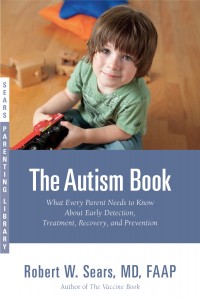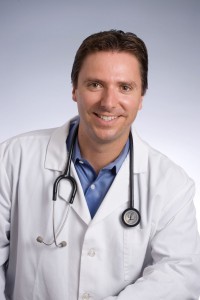By Rita Brhel, managing editor and attachment parenting resource leader (API)
 I have to admit that before I read the latest addition to the Sears Parenting Library – The Autism Book: What Every Parent Needs to Know about Early Detection, Treatment, Recovery, and Prevention by Dr. Robert W. Sears, MD, FAAP – that I had only a very basic idea of what autism was. The complexity of this medical disorder simply had me baffled, and because I thought I had no personal connection to autism, I conveniently stayed away from the topic.
I have to admit that before I read the latest addition to the Sears Parenting Library – The Autism Book: What Every Parent Needs to Know about Early Detection, Treatment, Recovery, and Prevention by Dr. Robert W. Sears, MD, FAAP – that I had only a very basic idea of what autism was. The complexity of this medical disorder simply had me baffled, and because I thought I had no personal connection to autism, I conveniently stayed away from the topic.
But when you’re involved in parenting support, at some point you have to break out of your comfort zone in order to help more families. And attached families certainly aren’t immune to autism.
A few years ago, Dr. Sears wowed us with his acclaimed The Vaccine Book. The Autism Book is just as wonderful. Personally, I have received quite an education from the book. It provides a comprehensive look on this medical condition, and has the added appeal in that it offers both an introduction to autism as well as all the latest research and theories on mainstream and alternative treatments — and even a bit on the subject of prevention. By the time I finished the book, I thoroughly understood all aspects of autism. Dr. Sears has written The Autism Book to be THE handbook on parenting a child with on the autism spectrum.
 In our interview, Dr. Sears gives us some insight to what he hopes to accomplish by writing The Autism Book.
In our interview, Dr. Sears gives us some insight to what he hopes to accomplish by writing The Autism Book.
RITA: How did you first become interested in autism?
DR. SEARS: Ten years ago, a new patient walked into my office [located in California, USA] with a child with autism. She asked for help guiding her through all the various treatment options. I knew absolutely nothing about autism at that time, but I wanted to help. So, I began learning everything I could through physician seminars, books, and mentoring under other doctors who specialized in autism.
Through this first patient, and several others in the following months, I learned that there is a whole world of treatment options out there. Some treatments help most kids and some only help a minority. But, I learned that children with autism can recover and lose their diagnosis, and after I saw this happen with several of my patients, I knew that treating autism as a pediatrician would become a lifelong passion for me. I also became involved in the parent support group, Talk About Curing Autism (www.tacanow.org), which has taught me so much in ways that only parents can teach a physician.
RITA: What led you to write your book, and how do you hope for your book to benefit families?
DR. SEARS: Treating autism requires a lot of time educating parents. So, I thought I’d throw everything I know into a book so my own patients could read everything I want them to know. But, I also love reaching out to families everywhere with information I feel is important. With the continually increasing rates of autism — and make no mistake, there is definitely an alarming increase, despite the denials you see in the media — early detection and early intervention are becoming more and more critical. The sooner a baby or toddler or child is identified as being on the autism spectrum, and the sooner intervention begins, the better the chance of a full — or nearly full — developmental recovery.
Physicians used to think, and I am admittedly guilty of this, that it didn’t matter what age a child was diagnosed, because there wasn’t much we could do about it. Autism was autism, and there was no hope for treatment or recovery. Now that we know the complete opposite is true, physicians and parents need to have the tools to detect autism at the earliest possible age so life-changing treatment can begin.
But with the various “alternative” medical treatments out there, I wanted to give parents a science-based look at what integrative and complimentary treatments could help there child, along with mainstream treatments. So, I put it all together for parents everywhere to be able to read. There are some treatments that require a doctor’s guidance, but there are so many treatments that parents can do on their own without a doctor’s help and I wanted to put such tools into parents’ hands.
RITA: Your book touches on prevention of autism, which I found very interesting but something we don’t hear much in mainstream media. Could you give an overview for our readers?
DR. SEARS: The last chapter of the book deals with prevention, in as much as prevention may be possible. I address how to identify autism-associated medical or nutritional problems early on and how to fix them, with the hope that such steps may prevent or limit the autism problems. I also discuss how to approach medical care in a way that may help be protective against autism, as well as how to prevent autism in subsequent children in families who already have one child with autism.
RITA: There is a study that began in 2008 seeking to determine whether mother-child attachment can be used as prevention for autism. What are your thoughts on this?
DR. SEARS: The issue on whether or not Attachment Parenting (AP) can help prevent autism is a tough one. We do know from research that AP kids tend to grow up smarter and happier, and that AP enhances intellectual and motor development during infancy. But, does this benefit extend to autism? I don’t know. I know AP kids who have developed autism. I don’t think we can speak to this until some research is done. My opinion, however, is that the neurobiological mechanisms that cause autism are so complicated that AP practices may not be enough to overcome the autism.
It’s very important not to cast blame on any parent for their child’s autism. And to suggest that a child with autism who was not attachment-parented may have turned out better if he had been AP’d is not an appropriate statement to make to any parent. So, until we know, I don’t like to presume that AP may help prevent autism.
RITA: What tips do you have for AP families affected by autism? Are there particular principles or parenting practices that are more helpful than others, or vice versa?
DR. SEARS: Autism behavioral interventions are very unique and complex. The proper way to interact with a child with autism might not always be intuitive. Specific behavioral interventions are usually provided one-on-one with a licensed therapist, and these techniques are usually taught to the parents, as well. I recommend parents become somewhat adept at the techniques they learn from such therapists. But of course, nothing can replace the loving care a parent can provide, and from an AP standpoint, patience is definitely a virtue.
One very important concept for parents to realize is that the divorce rate in families with autism is extremely high. Perhaps the single most important factor that keeps a family together is a father who accepts the child’s diagnosis and jumps into getting involved with the child’s therapy; a dad who understands what is going on and takes part in it. A dad, on the other hand, who steps back from the whole situation, and just views himself as the money maker for the family, may soon become detached from the family unit and will find a distance developing between himself, his child, and his spouse. Becoming active in a local parent and family autism support group can really help.
RITA: Could you summarize the top two or three concepts from your book for our readers?
DR. SEARS: The book is divided into four sections:
- Early detection: as discussed above, this concept is key so that early intervention, and a greater chance of recovery, can occur.
- Causes: I discuss what we know about possible causes. Much of this is theoretical, but we are learning more and more scientifically, as well. I also go over what type of testing is useful in order to look for associated medical and nutritional problems.
- Treatment: I go over behavioral/developmental therapy, nutritional therapies, and integrative (“alternative”) therapies. I don’t just give general advice – I provide specific guidance on exactly what to do and how to do it.
- Prevention: I provide information on how to lower a child’s risk of developing autism. This isn’t always possible, but I share what we do know and what parents can do.
Readers can check out the book’s intro and table of contents at www.theautismbook.com.
RITA: Thank you, Dr. Sears, for your time and insights. Any closing thoughts you’d like to share?
DR. SEARS: Autism used to be a diagnosis will little hope of treatment or improvement. Many kids were institutionalized. And although the diagnosis can be a very difficult time for families, today there is so much more hope and available treatment options than 20 years ago. There is a lot of work involved in autism treatment, but by seeking the help of other parents and the right professionals, improvement is very likely and recovery is possible.
2 thoughts on “The Autism Book: Interview with pediatrician Dr. Robert Sears”